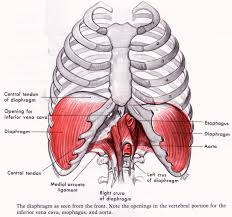
记忆方法
将“diaphragm”与“dia”联想,想象一个圆盘(“dia”代表圆盘或直径)在人体内,这个圆盘负责分隔和调节,就如同它是人体呼吸的“隔板”。通过这种视觉联想,有助于记忆“diaphragm”这个词与它作为横膈膜的功能相关。
以上内容由AI生成, 仅供参考和借鉴
中文词源
diaphragm 膈膜,光圈
来自希腊语diaphragma,阻挡,障碍,dia-, 穿过,-phrag, 阻挡,词源同cataphract. 原指分开喉咙和腹腔之间的肌肉,后也用于指照机的光圈等。
英语词源
- diaphragm
-
diaphragm: [17] The etymological notion underlying diaphragm is of a sort of ‘fence’ or ‘partition’ within the body. It comes via late Latin diaphragma from Greek diáphragma. This in turn was a derivative of diaphrássein ‘divide off, barricade’, a compound verb formed from the intensive prefix dia- and phrássein ‘fence in, enclose’. Originally in Greek diáphragma was applied to other bodily partitions than that between the thorax and the abdomen – to the septum which divides the two nostrils, for instance.
- diaphragm (n.)
- late 14c., from Late Latin diaphragma, from Greek diaphragma "partition, barrier, muscle which divides the thorax from the abdomen," from diaphrassein "to barricade," from dia- "across" (see dia-) + phrassein "to fence or hedge in." The native word is midriff. Meaning "contraceptive cap" is from 1933.
权威例句
- 1. The diaphragm vibrates , thus setting the air around it in motion.
- 膜片振动,这使得周围的空气也动荡起来.
- 2. The diaphragm draws air into the lungs.
- 横膈膜向下运动让空气进入肺部.
- 3. A portion of the cardia is demonstrated above the diaphragm.
- 膈上发现部分贲门.
- 4. Gastric distention may also reduce lung volume by elevating the diaphragm.
- 胃胀使膈升高也会减少肺的容积.
- 5. It was a terylene diaphragm coated with a layer of aluminum.
- 它利用一个镀有铝层的涤纶膜片.